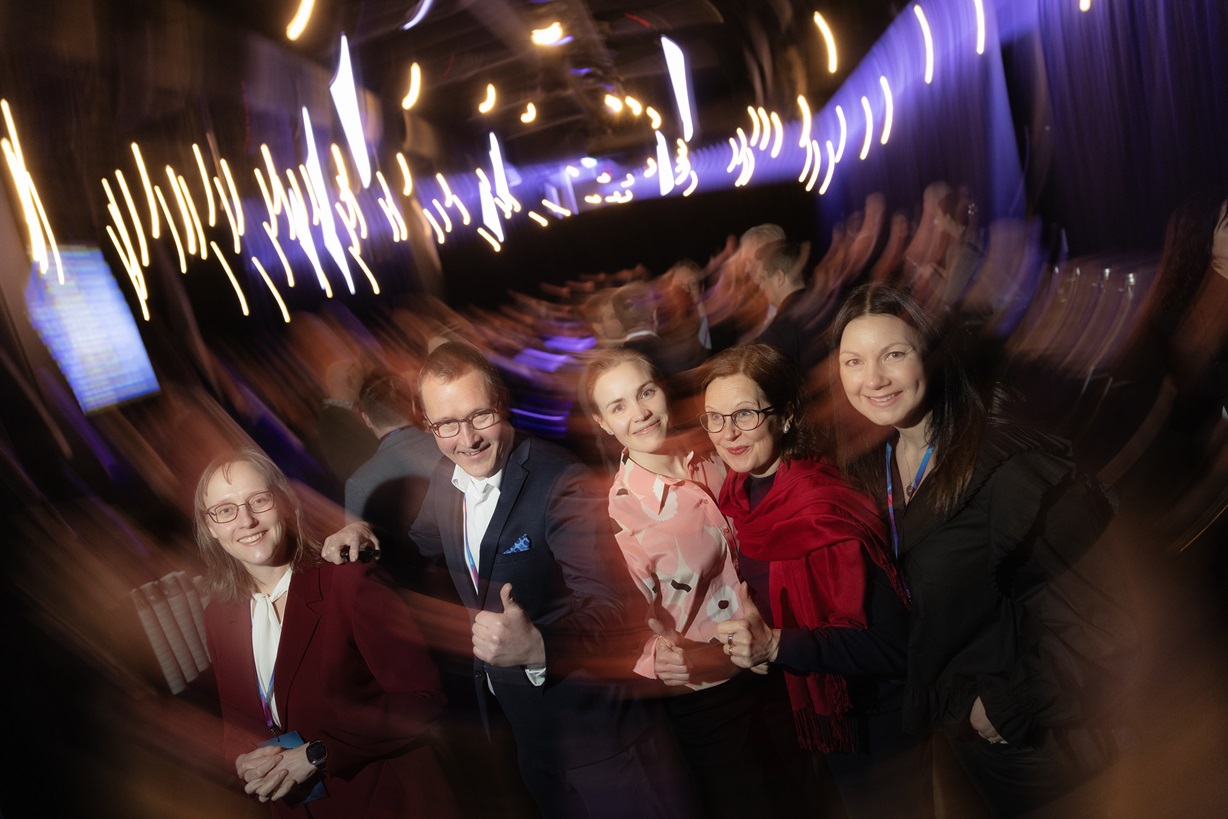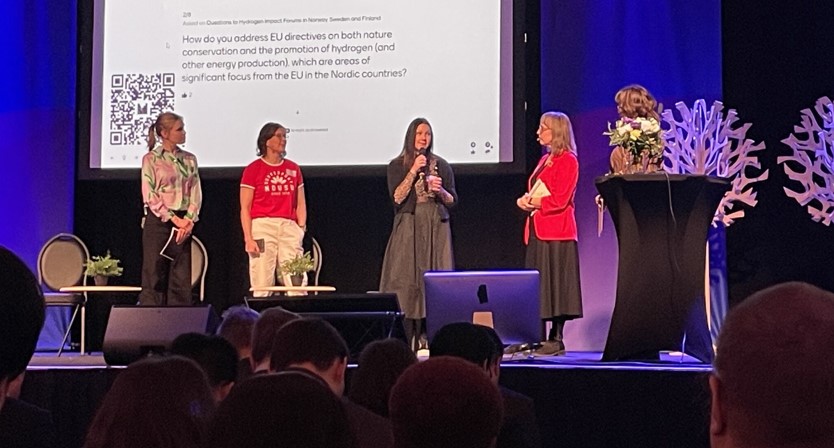
Finland, Sweden, and Norway face similar challenges regarding land use conflicts and the social acceptability of large-scale hydrogen projects, as well as the new energy production and electricity distribution needs associated with them. These shared challenges are valuable to address and discuss collectively. At the Nordic Collaboration for EU Transition event during Hydrogen Week in Oulu on February 12, 2025, Nordic actors from various sectors gathered to exchange best practices and lessons learned to improve local acceptance of hydrogen as part of the climate transition.
Hydrogen Impact Forums in Three Countries Identify Challenges and Opportunities
Hydrogen Impact Forums were organized in February across Norway, Sweden, and Finland, bringing together stakeholders to discuss the local impacts of hydrogen projects. The discussions in each country shared many common points. One significant highlight was the need for further dialogue and cooperation. More interaction is required both within regions, among various groups, and between local and national levels, especially within the EU. Cross-country collaboration was seen as particularly important to enhance security of supply.
The role of municipalities in hydrogen-related initiatives was viewed as strong in all three countries. However, there is a need to strengthen the role of regions. Empowering regions with greater responsibility for vision and planning would help create more coherent solutions and ease the burden on municipalities, which currently have large, distributed responsibilities within their borders.
Several northern regions are currently facing challenges from rapid demographic changes, which are becoming problematic not only for these regions but also for nations and NATO: without a population, there is no security. The situation is compounded by the fact that decisions enabling regional and municipal development are often made far away, in capital cities.
Country-Specific Challenges Revealed through Comparison
In Sweden, there was a strong focus on ensuring that economic value remains local. Local energy companies, for example, requested to have control over who should have priority access to electricity from a broader perspective. It was considered socially unacceptable if the transition led to rising electricity prices or if hydrogen produced from local wind power was exported abroad (e.g., to Germany) without processing. The hydrogen pipeline was identified as an area where more knowledge, development, and information dissemination are needed, especially concerning risks and safety.

The Norwegian Hydrogen Impact Forum emphasized the role of the Sami as part of northern Norway’s cultural heritage. It was highlighted that northern Norway’s wilderness is an integral part of people’s culture, identity, and way of life, even before any wind turbines or hydrogen plants are built. At the same time, the two main challenges for northern Norway are climate change and negative population growth. Existing businesses need to reduce emissions, and there is a pressing need for investment in new activities to stop the population decline. The key to success lies in ensuring that hydrogen projects and other investments actually contribute to building communities in northern Norway and provide sufficient value to municipalities and local businesses. These connections must be clearly communicated to the public.
In Finland, the Hydrogen Impact Forum in Oulu engaged in lively discussions about the climate benefits and biodiversity damage that any construction inevitably brings. The fairness debate also included wildlife, such as the once-common but now endangered willow tit. It was concluded that hydrogen’s potential could be realized while doubling the willow tit population if planning objectives included ecological compensation, such as replacing land areas with scientifically assured natural values.
Key conclusions include the importance of a common knowledge base to facilitate interaction and cooperation between stakeholders. Regional self-governance would motivate municipalities and cities to plan and identify their own position, goals, and roadmap within the hydrogen value chain.
In summary, the discussions in the three countries indicated that hydrogen projects, if planned with the needs of local communities in mind, can be successful. This can happen if space is created to discuss and agree on projects, if economic benefits stay local, and if local residents have easy access to project information. A crucial requirement is to strengthen regional planning and protect areas for both people and nature to ensure that overexploitation doesn’t occur.
Hydrogen Companies Address Challenges through Project Development
The main outcomes from the Hydrogen Impact Forums were presented at the Nordic Collaboration for EU Transition event in Oulu. The key challenges were addressed by business panels with representatives from various energy companies, including Fortum, Troms Kraft, Vattenfall, Gasgrid, Fingrid, Nordion Energi, Equinor, Liquid Wind, and Oulun Energia. These discussions focused on smooth consultation processes, building local sustainable infrastructure, equity, and local impact.

Representatives from companies emphasized that they are planning hydrogen projects while considering the rights of indigenous peoples in all three countries. They also stressed that cooperation with all stakeholders is crucial in order to respond swiftly to the common issue of climate change, while ensuring a just transition.
The importance of trust and transparency was highlighted by business representatives and the audience. Building trust between two or a few parties at a small negotiation table is relatively easy, but extending that trust to larger communities and regions is more challenging. While small-scale negotiations have a role early on, trust is ultimately built locally through an open and transparent process, which requires time and presence in the region.
Business stakeholders also agreed on the importance of creating local value in the form of social capital. They identified various ways in which projects and their value chains could benefit local communities, such as through training, jobs, services, and circular economy practices.
Decision-Makers Identify Alignment of Interests as Key
After the business panels, the challenges were picked up by political governance representatives: Filip Vestling, Deputy Director at the Energy Unit of the Swedish Ministry of Climate and Business; Kjell Giæver, Director of Arctic Energy Partners in Norway; and Timo Ritonummi, Deputy Director General at the Finnish Ministry of Employment and the Economy. They discussed the challenges of developing hydrogen projects in a political landscape where energy and industry compete for resources, including security concerns.

The panelists emphasized the need for international investment, new infrastructure, and Nordic cooperation. They also noted that part of the solution is ensuring that citizens feel included in the transition, rather than being left behind. However, reconciling interests was recognized as a challenge, as every policy decision tends to create resistance from one group. Nonetheless, the panel highlighted the need for policymakers to make tough decisions, pointing out that “you can’t make an omelette without breaking eggs.” If unpopular decisions are not made, the region risks missing out on vital investments.
In other words, the task is difficult, and the stakes are high. Further cooperation is simply needed to tackle the challenges.
Next Steps
At the end of the event, it became clear that Nordic cooperation to ensure the benefits and acceptance of hydrogen projects cannot stop there. A draft action plan was already being prepared in response to the political panel’s conclusion about the importance of reconciling various interests.
One audience member summed up the upcoming cooperation by suggesting: “Why just strive for acceptance—why not ensure that hydrogen projects are actually desired by northern communities?”
In February 2025, the Hydrogen Impact Forum in Finland was organized by the JustH2Transit project, funded by the Strategic Research Council (SRC), in collaboration with the Academy of Finland. In Norway, the event was organized by Energi i Nord. In Sweden, the Centre for Hydrogen Energy Systems Sweden (CH2ESS) at Luleå University of Technology hosted the event as part of the H2SIPP – Hydrogen Safety and Improved Permit Processes project, funded by Nordic Energy Research. The Nordic Collaboration for EU Transition event was organized in cooperation with Business Oulu, BotH2nia, and the projects Oulu GH2 (funded by the Regional Council of Northern Ostrobothnia) and BalticSeaH2 (co-funded by the European Union under Grant Agreement 101112047).